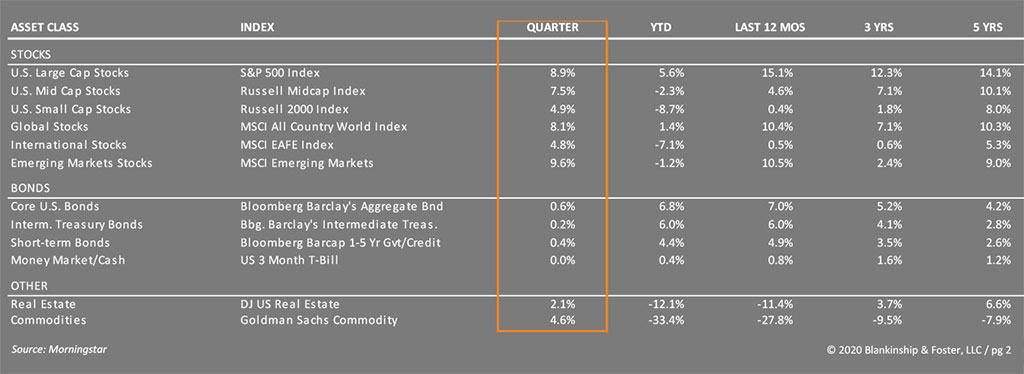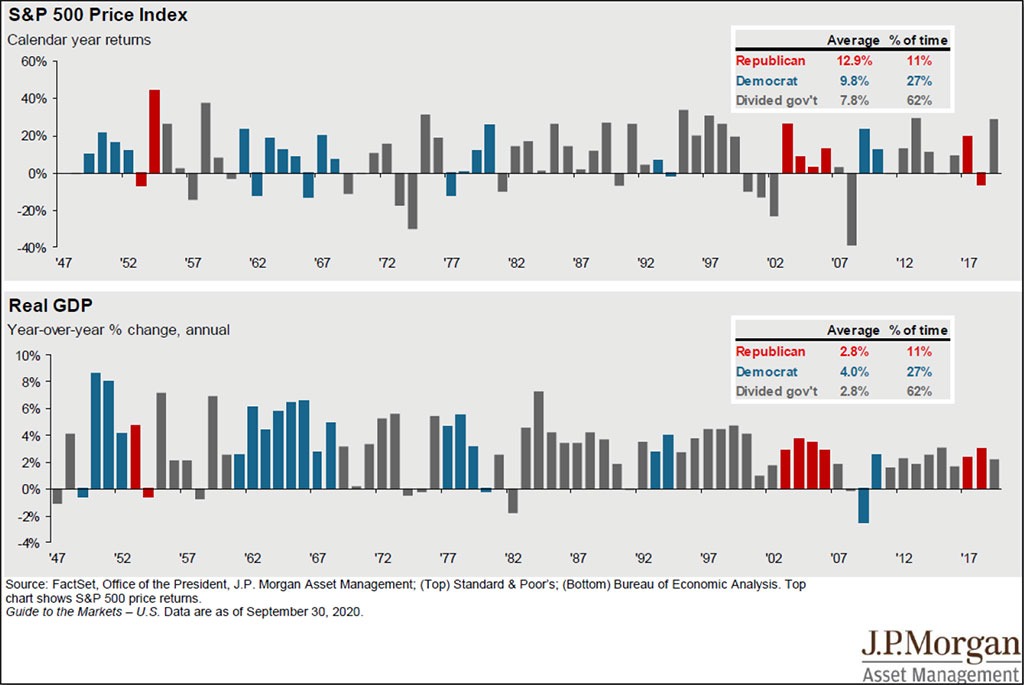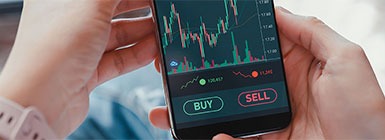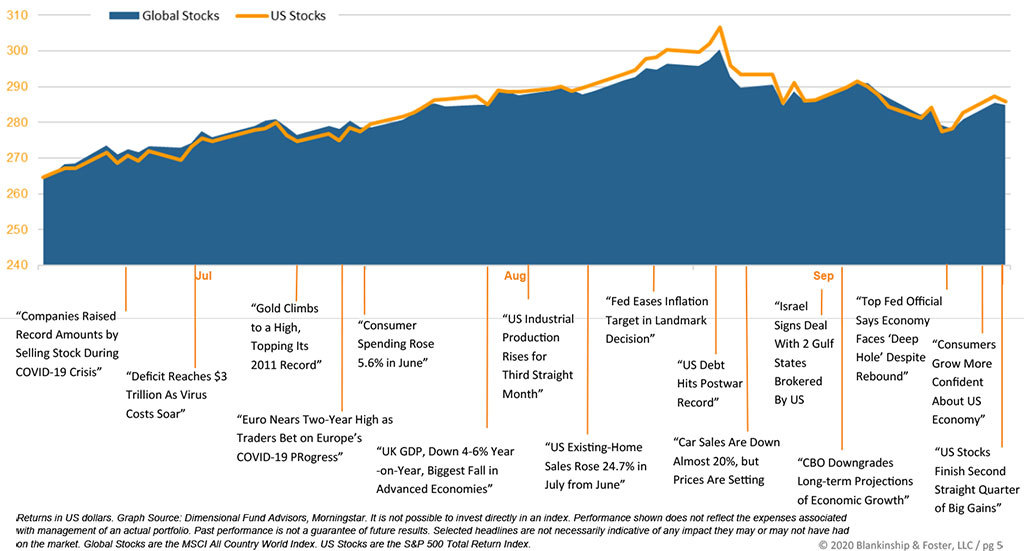Quarter in Review
The third quarter of 2020 was probably one of the strongest periods of economic growth in U.S. history as the economy recovered from near-total shut-down in the second quarter. Gross Domestic Product shrank at an annual rate of about -31% in the second quarter. Economists polled by the Wall Street Journal estimate that it should rise about 24% in the third quarter. Employment is improving, but there is still a long way to go. Furthermore, economic gains have begun to level off as layoffs and bankruptcies surge and COVID infection rates rise.
Equity markets continued higher during the quarter on the strong recovery in economic activity and expectations of additional fiscal support from Congress. Large U.S. company stocks, represented by the S&P 500 Index, gained another 8.9% during the quarter and are up 5.6% year-to-date. Smaller company stocks were also positive in the quarter, rising 4.9%, though they are still down -8.7% year-to-date. International stocks posted similar results: up 4.8% in the quarter still underwater by -7.1% for the year.
Bonds rose just 0.6% during the quarter as interest rates stabilized following the volatility earlier in the year. Bonds, often a safe haven during volatile markets, are still up 6.8% for the year so far.
Other assets have not fared as well. Real Estate investments are down more than -12% for the year on concerns about changing office habits and weak retail traffic. Master Limited Partnerships are down -46.2% year-to-date. High Yield (“junk”) bonds posted solid gains for the quarter (up 4.7%) but remain barely below break-even for the year.
Economy
Despite a strong improvement in economic activity during the quarter, Gross Domestic Product finished the second quarter down about 10% lower than it ended 2019 and is unlikely to fully recover from this loss before 2021. Indicators remain somewhat mixed. For example, pending home sales in August increased at the fastest rate in almost 20 years and consumer confidence had its biggest one-month gain in 17 years. Even so, personal income fell 2.7% in August as the enhanced unemployment benefits ended, posing challenges for the 10.6 million workers who remain unemployed. In that vein, payroll growth slowed from over 1.7 million in August to 661,000 in September.
FAQS
We’re happy to answer any questions you have about our firm and our processes. Here are answers to some of the questions we receive most frequently.

The good news for the markets, if you can call it that, is that the most heavily affected industries (travel, entertainment, retail, etc.) aren’t large contributors to index earnings. These (mostly service sector) jobs aren’t likely to recover fully before a vaccine is widely available. The S&P 500 has been driven higher largely by industries which either continue to benefit from people being stuck at home or by the reopening of industries which could work with proper precautions. Stock valuations continue to rise with the help of low interest rates and an expectation for a sharp recovery in corporate earnings.
Inflation has also stabilized, running at roughly 1.3% year-over-year at the end of the quarter. The Federal Reserve has also changed how they manage interest rates and fight inflation. By adopting an average inflation target (over a full market cycle), they have effectively promised to allow inflation to rise beyond the 2% level in order to make up for long periods of sub-2% inflation (like during recessions). This means interest rates are likely to stay low for much longer than would have been allowed during past recoveries.

One interesting side effect of the pandemic has been a spike in personal savings and the commensurate improvement in household balance sheets. Retail sales have recovered, though unevenly as spending decreased on discretionary items like dining out but increased on durable goods like home electronics.
State and local governments also face increasing pressure as tax revenues plunged during the first half of the year while pandemic related expenses have surged. Without fiscal support from the federal government, we expect to see more layoffs in government sectors as the economy struggles to get back to pre-COVID levels.

About The Election
Historically, elections have little impact on either the market or the economy. For ex-ample, according to JPMorgan, the stock market has performed better under Republicans since World War II: 12.9% for Republicans vs. 9.8% for Democrats and 7.8% for divided government. In contrast, the economy has performed better under Democrats, growing 4.0% vs. 2.8% under Republicans and 2.8% under divided government. Following every election, it’s common for investors to try to assess which industries might benefit from a change in policies or regulations, and to try to adjust portfolios accordingly. History, however, suggests that this short-term volatility is not reflected in long-run results.
Fiduciary
We are fiduciaries, and it’s not just a word. It’s a binding commitment to put your interests first.

Outlook
Investors should be prepared for volatility as COVID cases are expected to increase during the winter months and as investors digest the election results and its impact on state and federal policy. Part of the exuberance in the stock market is the expectation for an additional fiscal stimulus package from Congress. A delay on this front could impact stock prices.
We expect to see something of a tug-of-war between optimism and caution related to the pandemic which will likely continue into 2021. This will likely weigh on the prospects for growth in affected sectors and the broader economy. Markets expect corporate earnings to fully recover by 2021, supported in no small measure by additional federal spending.
While we are concerned about volatility in the short-run and high valuations in some corners of the equity markets in the longer-term, we do expect to see a return to something resembling pre-COVID economic activity by the end of 2021. This should include a significant level of pent-up demand as consumers who haven’t been comfortable travelling or dining out begin to do so again. Expectations remain for significant fiscal stimulus either late this year or early next year, supporting corporate earnings and potentially driving stock prices even higher.
Even if economic activity accelerates next year, the Federal Reserve has made it clear they plan to keep interest rates low for a long time in order to generate inflation above the 2% level. This will likely push investors seeking income into higher yielding, riskier assets like stocks and low-quality corporate bonds, fueling additional gains in these assets. That said, high quality, low risk government bonds remain the best tool in portfolios for risk reduction.
Emerging markets surged during the quarter and stand to benefit from improvement in global trade. Most emerging markets indexes are heavily weighted to the kinds of companies that rise and fall with the economic cycle. This was painful during the first half of the year, but as the pandemic comes under control and growth recovers, this should benefit emerging markets stocks which are currently much cheaper than U.S. or even developed market stocks in Asia and Europe.
ARTICLE
Invest $100K the Right Way
At some point, you may find yourself with $100,000 in the bank and questions on how to invest it.

Our Portfolios
Generally speaking, our portfolios have held up well during the recent market decline and subsequent recovery. Rebalancing (selling bonds and buying cheaper stocks) has played a role, as has the discipline of simply staying the course even when markets have been turbulent. We see no reason to alter this strategy heading into the volatility of the election season.
Our stock exposure is currently broad based and weighted towards large U.S. companies, which have proven remarkably resilient so far. Our fixed income positions continue to provide stability and diversification, if less than exciting income in this period of low yields. We reduced our exposure to corporate credits as default rates have been rising, further improving the stability provided by these investments.
Clearly, we are still not yet out of the woods, but it does seem the worst of the market volatility is behind us. That does not mean that stocks cannot trade lower, especially if COVID outbreaks during the colder months force states to re-impose shutdown measures.
As always, we are here for you, and we are ready to provide the guidance and planning you expect from us. If you have any questions about your investments or your financial plan, we would love the opportunity to discuss them with you.
Global Stock Market Performance
The chart below shows the change in global equity markets throughout the year. Juxtaposed over the market performance are some of the key events that occurred during the period. Sometimes as we get to the end of a volatile period, it’s difficult to look back and remember everything that happened along the way.


